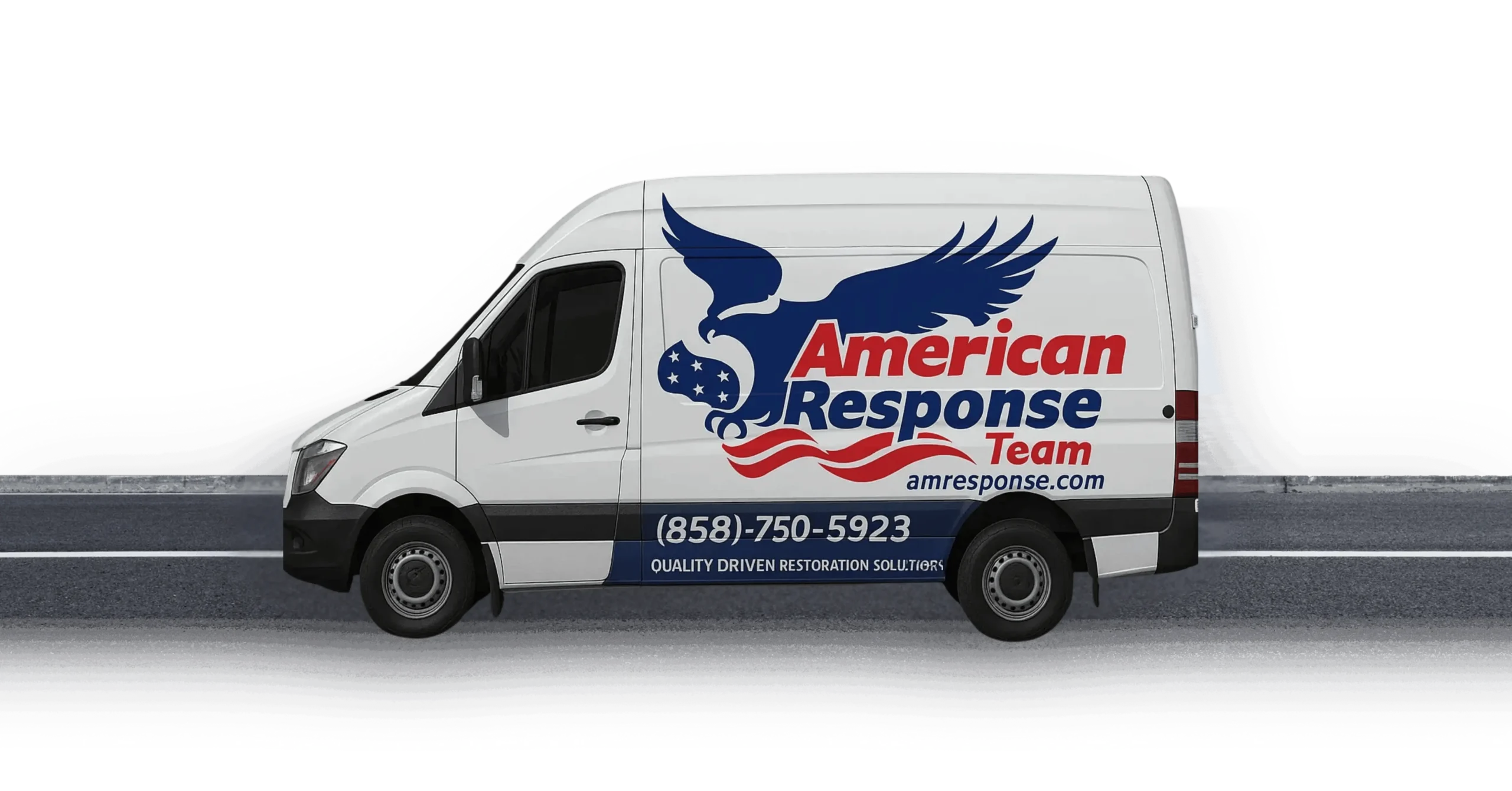Water damage creates awful smells that can make your home feel unsafe and unlivable. These musty, sour odors happen when water sits too long and allows bacteria and mold to grow. The good news? You can learn exactly how to get rid of water damage odor using the right techniques and tools.
Water damage odors don’t just smell bad – they signal serious problems brewing in your home. When water gets trapped in walls, carpets, or furniture, it creates the perfect environment for harmful microorganisms to multiply. The EPA warns that mold can start growing within 24-48 hours of water damage, and those spores produce the musty smells homeowners hate.
Why Water Damage Creates Strong Odors
Understanding why water damage smells so terrible helps you fight it more effectively. When water enters your home, several things happen that create odor problems:
Bacteria starts multiplying rapidly in damp conditions. These microorganisms break down organic materials like wood, paper, and fabric, releasing gases that smell musty or sour. The longer water sits, the worse these odors become.
Mold spores that are always present in the air find wet surfaces to land on and grow. As mold colonies spread, they release chemical compounds called microbial volatile organic compounds (mVOCs). These chemicals create the distinctive musty smell most people associate with water damage.
Sewage contamination makes odors much worse. When flooding involves contaminated water from sewers or septic systems, dangerous bacteria like E. coli and Salmonella add foul smells to the mix. The CDC requires special handling for contaminated water situations because they pose serious health risks.
7 Proven Methods for How to Get Rid of Water Damage Odor
1. Remove All Standing Water and Moisture Sources
You cannot eliminate water damage odors without first removing all moisture. This step is absolutely critical – trying to mask smells while water remains will fail every time.
Use powerful water extraction equipment like truck-mounted vacuums or portable extractors. Remove standing water from floors, carpets, and furniture as quickly as possible. The professional water damage restoration process starts with rapid water removal because every hour counts.
Check hidden areas where water might be trapped. Look behind appliances, inside wall cavities, and under flooring materials. Water can travel surprisingly far from its original source, creating odor problems in unexpected places.
2. Thoroughly Dry All Affected Materials
Proper drying goes far beyond what most homeowners attempt on their own. Professional-grade dehumidifiers and air movers are essential for getting materials truly dry.
Set up industrial dehumidifiers to pull moisture from the air. These machines can remove 150+ pints of water per day, compared to small home units that might remove 30 pints. Position air movers to create airflow across wet surfaces, speeding evaporation.
Monitor moisture levels with professional meters. Materials must reach specific moisture content levels before they’re considered dry. Wood should read below 19% moisture content, while drywall should be below 1% to prevent continued odor problems.
3. Remove Contaminated Porous Materials
Some materials cannot be properly cleaned and will continue producing odors no matter what you try. Identifying these materials early saves time and prevents ongoing smell problems.
Carpet and padding typically must be removed after significant water damage. These materials absorb huge amounts of water and provide ideal conditions for bacterial and mold growth. Even if carpet looks clean after cleaning, odors often return because bacteria remain deep in the fibers.
Drywall may need to be cut and removed, especially if water wicked up more than 24 inches from the floor. The paper backing on drywall feeds mold growth, and contaminated sections will continue causing odor problems. Leaving contaminated materials in place often leads to much more expensive problems later.
Insulation usually requires replacement when it gets wet. Fiberglass and cellulose insulation lose their effectiveness when soaked and become breeding grounds for microorganisms that create ongoing odors.
4. Apply Professional-Grade Antimicrobial Treatments
Once surfaces are clean and dry, antimicrobial treatments help prevent future bacterial and mold growth that could restart odor problems.
EPA-registered antimicrobial solutions are applied to all affected surfaces. These products are specifically designed for water damage situations and are much more effective than household cleaners. Professional restoration companies use products that meet IICRC S500 standards for water damage restoration.
Fogging treatments can reach areas that are difficult to access manually. Antimicrobial fog penetrates into cracks, crevices, and porous materials to kill microorganisms that cause odors. This technique is especially useful for treating HVAC systems that may have spread contamination throughout the building.
5. Use Advanced Odor Neutralization Technology
After removing the source of odors, you may still need technology to eliminate remaining smell molecules from the air and surfaces.
Hydroxyl generators create safe oxidizing molecules that break down odor compounds at the molecular level. Unlike ozone generators, hydroxyl machines are safe to operate while people and pets remain in the building. These machines work continuously to eliminate odors without masking them.
Thermal fogging uses heat to create tiny particles that penetrate deeply into materials and neutralize embedded odors. This technique is particularly effective for smoke and chemical odors that may accompany water damage from certain types of incidents.
Ozone treatment may be appropriate for unoccupied buildings when used by trained professionals. Ozone generators create molecules that react with and destroy odor compounds, but they require special safety protocols since ozone is harmful to breathe.
6. Clean and Treat HVAC Systems
Your heating and cooling system can spread odor-causing contaminants throughout your entire home if it gets contaminated during water damage incidents.
Inspect ductwork for moisture intrusion and mold growth. Water damage often affects HVAC systems, especially when flooding occurs or when roof leaks allow water to enter duct systems. Contaminated ducts must be professionally cleaned to prevent odors from circulating.
Replace air filters immediately after any water damage incident. Standard filters cannot capture mold spores and bacteria that may be circulating, so upgrading to HEPA filters temporarily provides better protection while cleanup continues.
Clean evaporator coils and condensate drain pans. These components collect moisture naturally and can become breeding grounds for bacteria if they get contaminated during water damage incidents.
7. Address Hidden Water and Moisture Issues
Sometimes water damage odors persist because moisture problems remain hidden from view. Professional moisture detection equipment helps locate these problem areas.
Use thermal imaging cameras to identify moisture trapped inside walls and other building cavities. These cameras detect temperature differences that indicate moisture presence, even when visual inspection doesn’t reveal problems.
Check for ongoing moisture sources like leaking pipes, poor ventilation, or drainage issues that could keep feeding odor problems. Professional leak detection services use specialized equipment to find hidden plumbing leaks that may be causing continued moisture issues.
When to Call Professional Restoration Services
Learning how to get rid of water damage odor often requires professional expertise and equipment. Several situations definitely require professional help:
Category 3 water damage involves sewage, toilet overflows, or flooding from contaminated sources. OSHA requires special safety procedures for these situations because they pose serious health risks.
Large affected areas (more than 10 square feet) typically require professional remediation. The EPA recommends professional help for extensive mold growth because improper handling can spread contamination to clean areas.
Persistent odors that return after attempted cleanup indicate that moisture sources or contaminated materials remain. Professional moisture detection and comprehensive remediation may be necessary to solve these ongoing problems.
Health concerns arise when family members experience respiratory symptoms, allergic reactions, or other health issues that may be related to water damage odors. Professional mold testing and remediation may be necessary to ensure a safe indoor environment.
Prevention: Stopping Future Water Damage Odors
Understanding how to get rid of water damage odor is important, but preventing future incidents protects your family and your investment better than cleanup after the fact.
Maintain proper humidity levels between 30-50% relative humidity. Use dehumidifiers in basements and other moisture-prone areas. Monitor humidity with inexpensive digital hygrometers available at hardware stores.
Fix water leaks immediately when you discover them. Even small leaks can cause major odor problems if left untreated. Mold can begin growing within 24-48 hours of water intrusion, so speed matters.
Improve ventilation in bathrooms, kitchens, and laundry rooms. Exhaust fans should vent outside, not into attics or other enclosed spaces. Run fans during activities that create moisture and for 30 minutes afterward.
Clean gutters and downspouts regularly to prevent water from pooling near your foundation. Ensure proper grading around your home so water drains away from the building rather than toward it.
Understanding the Costs of Odor Removal
Professional water damage odor removal costs vary depending on the extent of contamination and the methods required. Simple surface cleaning and deodorizing might cost $500-1,500 for small areas, while comprehensive remediation including material removal and replacement can reach $5,000-15,000 or more for severe cases.
Insurance coverage depends on the cause of water damage and your specific policy. Sudden accidents like burst pipes are typically covered, while gradual leaks or flooding may require special coverage. Document all damage thoroughly and contact your insurance company immediately to understand your coverage.
The cost of professional treatment is almost always less than the cost of ignoring odor problems. Mold remediation expenses increase significantly when contamination spreads to additional areas of your home.
Take Action Against Water Damage Odors Now
Learning how to get rid of water damage odor effectively requires quick action and the right approach. Every day you wait allows bacteria and mold to spread, making odors stronger and remediation more expensive.
Start with moisture removal and proper drying, then move through the cleaning and deodorization process systematically. When dealing with extensive damage, contaminated water, or persistent odors, professional restoration services provide the expertise and equipment needed for complete odor elimination.
Remember that masking odors with air fresheners or other temporary solutions does not solve the underlying problem. True odor elimination requires removing the sources of contamination and treating affected areas thoroughly.
If water damage odors are making your home unlivable, don’t wait for the problem to get worse. Professional restoration services can eliminate odors completely and restore your home to a healthy, comfortable environment for your family.

